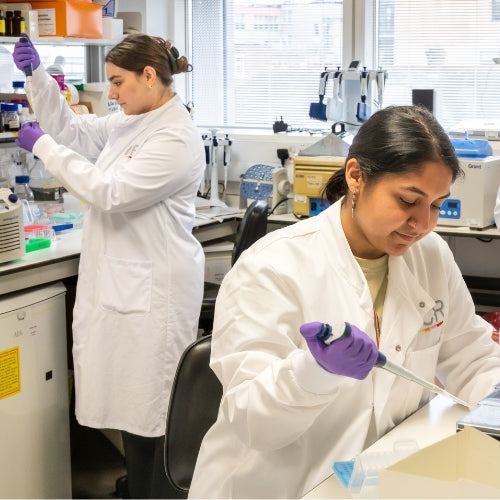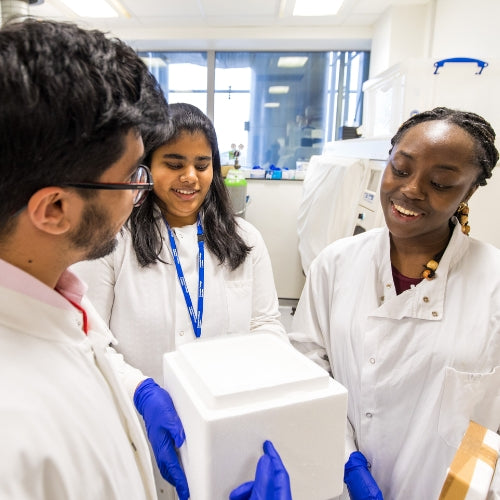Glioma
How are gliomas treated?
Collapsible content
Surgery
The goal of surgery is to remove as much of the tumour as possible while preserving essential brain functions.
In some cases, a neurosurgeon may perform a resection to cut out the tumour. However, complete removal might be challenging or ill-advised, especially if the tumour is located in critical or inaccessible areas of the brain.
Radiation Therapy
Radiation therapy is often used to target remaining tumour cells after surgery or to treat tumours that cannot be surgically removed.
External Beam Radiation is when high-energy beams are directed at the tumour from outside the body. Brachytherapy involves radioactive material being placed directly into or near the tumour.
Chemotherapy
Chemotherapy may be used in addition to surgery and radiation as adjuvant therapy to target remaining cancer cells.
Temozolomide is an oral chemotherapy drug commonly used in the treatment of glioblastoma.
Targeted Therapy
Targeted therapies aim to interfere with specific molecules involved in the growth and progression of cancer cells.
Bevacizumab is an anti-angiogenic drug which may be used to inhibit the formation of new blood vessels that supply the tumour.
Immunotherapy
Immunotherapy is an evolving area of research, aiming to harness the body's immune system to recognize and attack cancer cells.
Checkpoint Inhibitors are drugs that target immune checkpoints, enhancing the body's ability to mount an immune response against the tumour.
Clinical Trials
Participation in these may provide access to experimental treatments and contribute to the advancement of glioma research.
Ongoing research explores new drugs and treatment strategies to improve outcomes for patients with gliomas.
Supportive Care
Glioma treatment may have side effects and supportive care is essential to manage symptoms such as pain, seizures, and neurological deficits.
Physical and occupational therapy may be employed to help patients regain or maintain functional abilities.
Follow-up Care
Regular follow-up visits are crucial to monitor the patient's condition, assess treatment response, and address any emerging issues.
Imaging studies, such as MRI or CT scans, are often used to monitor for tumour recurrence or progression.
Is glioma a low-grade (benign) or high-grade (malignant) brain tumour?
What is the survival rate for glioma?
Why are there different names for different types of glioma brain tumours?
Is glioma always fatal?
Frequently Asked Questions
What is a mixed glioma?
A mixed glioma is a glioma brain tumour that contains a mix of glial cells including astrocytes, oligodendrocytes and ependymal cells.
What is an optic nerve glioma?
An optic nerve glioma is a slow-growing tumour that originates from glial cells along the optic nerve, the pathway connecting the eye to the brain. Primarily diagnosed in children, especially those with neurofibromatosis type 1 (NF1), symptoms may include peripheral vision loss and optic disc swelling. Diagnosis involves eye exams and imaging studies, and treatment varies based on tumour size and symptoms. Small, asymptomatic tumours may be monitored, while larger ones may require surgery, radiation, or chemotherapy. Early detection and a multidisciplinary approach are crucial for managing optic nerve gliomas and preserving vision.
What is molecular testing and what do molecular markers of glioma brain tumours mean?
Current UK guidelines for the classification of gliomas defined by the National Institute for Clinical Excellence (NICE) state that tumours should also be tested for various molecular markers.
These markers include: IDH1 and IDH2 mutations, ATRX mutations, 1p/19q codeletion to identify oligodendrogliomas, Histone H3.3 K27M mutations in midline gliomas and BRAF fusion and gene mutation to identify pilocytic astrocytoma.
In addition, clinicians should test all high-grade glioma specimens for MGMT promoter methylation to inform prognosis and guide treatment. They should also consider testing IDH-wildtype glioma specimens for TERT promoter mutations to inform prognosis.
IDH1 and IDH2 status
IDH stands for “Isocitrate Dehydrogenase”. This is an enzyme involved in the production of energy by brain tumour cells. Research has indicated that different forms of gliomas have differences between these enzymes, though their exact role is still being explored, as are drugs that can potentially influence IDH enzymes.
IDH 'wild' type status
Glioma tumours that have IDH-wildtype status are classified as glioblastoma tumours. These grade 4 brain tumours are fast growing and aggressive.
IDH mutant
Glioma tumours that are IDH mutant are likely to either be an astrocytoma (astrocytoma, IDH-mutant) or an oligodendroglioma (oligodendroglioma, IDH-mutant). These can be classified as grades 1-4 depending on the patient’s tumour.
ATRX mutations
The ATRX gene provides instructions for making a protein that plays an essential role in normal brain development. If the ATRX protein is mutated and doesn’t function properly, it can contribute to the development of certain types of glioma brain tumour.
IDH NOS
This stands for “Not Otherwise Specified”, meaning that in rare cases, it cannot be determined whether a tumour is 'wild' type or mutant for IDH.
1p/19q deletion
This refers to missing genes on chromosomes and tumours with this “deletion” may respond better to certain chemotherapy drugs such as Temozolomide or Carmustine.
Histone H3.3 K27M mutations in diffuse midline gliomas
A histone is a type of protein that is found in chromosomes and mutations in this protein can help identify diffuse midline gliomas and guide treatment.
BRAF fusion and gene mutation in pilocytic astrocytoma
The BRAF gene can become fused with a number of different proteins, or undergo other mutations that are found in pilocytic astrocytoma brain tumours. In particular, the fusion of BRAF and KIAA1549 proteins is a diagnostic marker for this tumour type.
MGMT methylation
This is short for O6-methylguanine-DNA methyltransferase and whether it is 'methylated' or 'unmethylated' indicates how effectively the tumour cells can repair the damage inflicted on them by certain chemotherapy drugs, such as Temozolomide. Patients with higher levels of MGMT methylation respond better to Temozolomide treatment. Methylation means the transfer of a methyl group (CH3) from one molecule to another, which affects the way the tumour behaves.
TERT promoter mutations in glioma brain tumours
TERT stands for telomerase reverse transcriptase. It is an enzyme that affects telomere length in human cancers including glioma. Telomeres are structures at the end of chromosomes that can indicate expected lifespan.
Unfortunately, long relative telomere length combined with TERT-promoter mutations indicate that the glioma is likely to be resistant to radiotherapy and hence the prognosis is worse than for gliomas without this genetic marker.
Can a glioma be cured?
The ability to cure a glioma depends on several factors, including the type and grade of the tumour, its location, and the patient's age and overall health.
Low-grade gliomas (such as pilocytic astrocytoma) and some types of oligodendrogliomas may be more curable than other types of gliomas. In some cases, these tumours may be removed surgically and may not require further treatment.
However, high-grade gliomas (such as glioblastoma) are more difficult to cure. These tumours tend to grow quickly and spread aggressively, and they may be resistant to treatment. While surgery, radiation therapy, and chemotherapy can help slow the growth of these tumours and prolong survival, they are generally not curative.
How can we find a cure for gliomas?
Research we are funding across all of our Centres of Excellence will help lead towards finding a cure for glioma brain tumours.
Pioneering research at our Brain Tumour Research Centre of Excellence at Queen Mary University of London is focused on using glioblastoma stem cells to help develop unique, patient-specific treatments.
Our team at the University of Plymouth Brain Tumour Centre of Excellence are researching a range of mutations in brain tumour cells that initiate tumour progression and drive growth, transforming slow-growing low-grade gliomas into high-grade gliomas. Their discoveries are designed to enable new treatments to be developed and tested in order to halt and hopefully reverse this process. The team are also testing combination therapies for low-grade brain tumours, designed to enhance the effectiveness of existing treatments.
The team of research and clinical experts at our Centre of Excellence at Imperial College, London, are part of a global collaboration looking at how the ketogenic diet can influence glioma metabolism and help in the effective treatment and management of living with this brain tumour.
We also fund BRAIN UK at Southampton University, the country’s only national tissue bank registry providing crucial access to brain tumour samples for researchers from all clinical neuroscience centres in the UK, effectively covering about 90% of the UK population, and an essential component in the fight to find a cure for glioma brain tumours.


